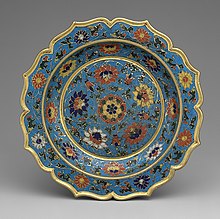With a rise in technology, the scope of glass art is also jacking up. There are many advance techniques used for creating unique products. Glass enameling is one such method used by glass art manufacturers.
Glass enameling is an age-old craft. It is a method of fusing glass in a pattern or a design onto a metal substrate. It is widely used in kitchenware, jewelry, watches, and other building applications.
In this blog, we will discuss some popularly used glass enameling techniques.

Techniques of Glass Enameling
-
Cloisonné
This technique involves making raised metal cells. Afterwards, the ground and powdered form of enamel are filled in these cells. Then, the metal piece is kept in the furnace to melt the enamel. Some artists also use glass-blowing torches to melt the enamel in cells.
-
Champlevé
Contrary to cloisonné, in this technique, the artists carve the design or pattern on the metal. Then, they put the powdered enamel into the carved areas.
-
Miniature
In this technique, the vitreous enamel is straight away painted onto the metal substrate.
-
Paillonné
Paillon means a piece of foil. In this technique, a foil is placed between two coatings of enamel to get a dazzling shimmery effect.
-
Basse-taille
In this technique, cuts, of different specifications, are made into metal. These cuts can be created by carving, engraving, or stamping. After that, these are fired with a torch or in a furnace. This gives the enamel different tones of the same color. Usually, glass artists prefer green and blue colored enamels as they have a wide palette of shades.
-
Plique-à-jour
Have you heard of stained glass? In this technique, the enamel is worked upon to look like stained glass. First, the artist adds enamel powder into a cell covered with a sheet of copper foil or the same kind of metal. Then this enamel is fused with a torch. After that, the copper foil is also removed using an acid. That’s it! You get a translucent, shimmery enamel.
-
Guilloché
In this technique, the metal is initially placed on a lathe. This machine carves out intricate designs into the metal. This method of cutting a design in the metal with a machine is known as engine turning. After this, powdered enamel is coated over the metal piece and the firing process is carried out. Once it is done, the design will peek through the transparent enamel.
-
Limoges
This technique is the most popular one. Limoges was popularly used between the twelfth and the fifteenth century. The artists used to delve into the metal surface or make a raised design on it to create a pattern and avoid the mixing of pigments.
Process of Enameling
As mentioned above, the techniques of enameling are quite different from each other. But, the steps in the process remain more or less similar.
-
Cleaning
Begin the process by cleaning the surface of metal substrates. Make sure there is no oil residue or dust on the metal surface else the enamel will not cling to it properly.
-
Cutting or Carving
Then, start by cutting, shaping, or filing the metal substrates. For enamel jewelry, drill the holes or solder the wires wherever necessary.
-
Firing
Now, fire a couple of coats or more of finely powdered enamel on the back of the piece. After fusing the piece, let the metal and glass cool at their own pace. Make sure the metal piece is enameled on both sides to avoid the risk of breaking.
-
Cleaning
Once the metal and enamel have cooled down, clean the oxidation (if any) due to the firing process.

Practice The Art of Enameling!
Just like other glass art techniques, enameling is also a master technique. Hope this blog helps you know everything about glass enameling and its age-old to modern techniques.
Are you stepping into the glass industry? Get more than just this knowledge about enameling. Our team at Art Glass Supplies will help you with everything you need for your glass art business.

